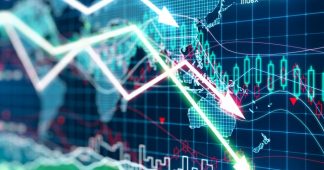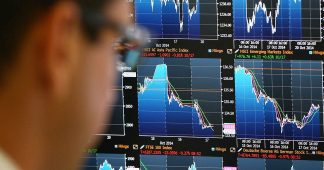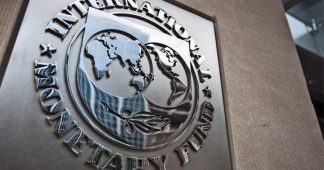Faced with another global recession, many governments are responding with even stronger state interventions than they did in the 2008 financial crisis. But stimulus packages to prop up businesses must also pose the question of public control — not just bailing out corporations, but repurposing their operations to confront the disasters ahead of us.
By Ingar Solty
March 23, 2020
Massively disrupting international supply chains, the globalization of COVID-19 has clearly accelerated a recession. Note the word “accelerated.” For already by late 2019, indicators from GDP growth to capital profitability and the volume of working hours indicated that recession was coming. In Germany, last year saw the lowest growth since 2009. Mass layoffs in the global auto industry were no longer merely results of computerization or the transition to e-mobility, but were connected to a wider slump in economic activity.
But the shutdown due to coronavirus has made the general public realize that the world is back in the kind of situation it faced in 2008. In the second week of March, stock markets plummeted: from March 4 to 18, the Dow Jones index dropped from 27,091 to 19,899 points, and the German DAX from 12,128 to 8,442. While pro-labor economists like Stephan Kaufmann called for a shutdown of stock exchanges in order to halt the volatility and panic-induced downward spiral (similar to the 1997 Asian crisis or the 9/11 crash of 2001), Wall Street soon demanded a “shock-and-awe stimulus” to halt the economic impact.
Just as the situation following the 2008 global financial crisis was characterized by major struggles over the social fallout, the same can be expected of the years to come. For the solutions will also have to answer crises encompassing the economy, social reproduction, social cohesion, democracy, world order, and the climate. Hence, much depends on whether working-class movements worldwide are capable of turning this crisis into an opportunity for radical social and ecological change.
Like any big or organic crisis of capitalism, the current one has many dangers and is not just an “opportunity.” The bourgeoisie proved able to use the 2008 crisis to deepen neoliberalism — not just stripping back the state, but also using it to entrench its own power. The short-lived Keynesian resurgence of 2008–9 was eventually replaced by an almost global austerity turn, shifting the relationship of forces between capital and labor further in capital’s favor.
Fast forward to 2020, and the disruption of international supply chains due to the lockdown in China has already created severe problems in the sphere of production, given how vulnerable just-in-time production is to external shocks. Global capitalism’s logistics industries have entered into deep crisis: shipping and airlines are on the brink of bankruptcy and have already requested state bailouts. The coronavirus shutdown is also putting retail and commercial industries on the verge of bankruptcy. Stefan Genth, CEO of Germany’s Federal Retail Association, announced that it had calculated the industry’s losses owing to the shutdown at €1.15 billion. He warned of a wave of bankruptcies within the next four weeks, especially in textiles and durable trading goods.
The question, then, is who will pay for the crisis — whether we will see a bailout of the working class or another bailout of ailing industrial and finance companies. In the aftermath of the global financial crisis of 2007–8, it became clear that workers would pay, in the guise of austerity. The crisis’s economic costs took the form of an “internal devaluation,” cutting costs and wages in the name of “competitiveness.” In many places, this meant rolling back collective-bargaining agreements and minimum wages, as well as cuts to public pensions, welfare benefits, public education, and health-care provision. Hence, it also meant fewer intensive-care beds in public hospitals — something we are again paying for as the COVID-19 crisis unfolds, with the vulnerable and elderly dying in the thousands.
Stimulus Programs, but What Kind?
So how have governments responded so far? Fearing, like the US government, that unemployment will skyrocket to 20 percent — and with the International Labour Organization warning that global unemployment will soar by an extra 24.7 million — governments responded quickly with bailout measures. Just like in 2008, even many leftists welcomed these actions as an end to neoliberalism, simply because “balanced budget” rules like Germany’s “black zero” have been thrown out the window.
But just because states are throwing money at the crisis doesn’t mean that neoliberalism is finished. In 2008, the Economist said there must be “no penny-pinching” during the crisis but this should be followed by strict austerity once it was “over.” In other words, once the state had socialized the losses, it could move on to making the working class pay for corporate debt and bank bailouts.
So far, states’ responses to the present crisis have largely followed the blueprint of 2008. State action was particularly swift in monetary policy. Usually, this has meant lowering interest rates in order to stimulate investment and growth — based on the neoliberal wisdom that capitalists will invest as long as money is cheap and liquidity preserved. Hence the raft of quantitative easing measures. Yet states are not only following the model of 2008, but using specific mechanisms resulting from that earlier crisis.
We see this in the mechanism deployed by the Federal Reserve, which can now directly provide capitalist enterprises with loans. In 2008, the Fed lowered interest rates close to zero in order to stimulate economic activity. However, based on their rational estimates of loan risk faced with stagnant growth, low profitability, and economic volatility, the commercial banks did not pass on these low interest rates to businesses — spurring a credit crunch and liquidity crisis. In order to prevent this happening again, the new mechanism circumvents commercial banks.
But such a mechanism, where the Fed has direct credit lines to corporations, also has a strong class bias. It provides cheap money for big business while credit lines freeze up for workers, self-employed people, and small-business owners who still need to seek credit from the risk-averse commercial banks. In other words, the Fed is pursuing a bailout policy for Wall Street at the expense of Main Street. And this bailout, echoed in Great Britain by a £300 billion program of loan guarantees for businesses, is expensive. The volume of such Federal Reserve loans is estimated to range between $700 billion and $1.5 trillion.
Treasury secretary Steve Mnuchin, a former Wall Street hedge fund manager and notorious “foreclosure king,” further announced on March 17 that the US government would reinstate the Primary Dealer Credit Facility (PDCF). Earlier, former Fed chiefs Ben Bernanke and Janet Yellen had joined forces in an op-ed published in the Financial Times urging the Trump administration and Fed chairman Jerome Powell to pursue such action. In 2008, the PDCF saw the government buy out toxic assets from private and for-profit investment banks, which Wall Street bankers have come to love as the “cash-for-trash facility.”
This time around, Bernanke and Yellen argued that the state should buy “investment-grade corporate debt” in order to “help restart that part of the corporate debt market, which is under significant stress.” In 2008, the government argued that these buyouts were temporary loans. Assets were to be returned to Wall Street firms once the storm had been weathered. The argument was that these loans, issued to the magnitude of $8.95 trillion, would benefit American workers and companies.
However, in reality, at least 64 percent ($5.7 trillion) went to the largest Wall Street banks, such as Citigroup, Morgan Stanley, and Merrill Lynch, which had exploited financial deregulations for high-risk leveraging and collateralized debt obligations trading, and which had then blackmailed the state into bank bailouts because they were “too big to fail.” Most of the money was now used not to re-stimulate economic activity, but rather to even further increase the centralization and concentration of capital through mergers and fire-sale acquisitions of smaller banks, as well as bonus payouts that rightly outraged the public.
Neoclassical economists and right-wing libertarians like Ron “End the Fed” Paul suggested that these banks should have been left to perish. But they really had become “too big to fail” — and letting them collapse would have provoked a financial meltdown with horrific consequences. Yet the state’s actions helped the banks to become even bigger, ensuring that, after this successful blackmail, they could from now count on future bailouts. Here, we see that banks that are “too big to fail” are “too big to be private.” The current crisis strikingly illustrates that these banks ought to be public utilities allowing states to steer and direct investment to socially useful purposes — to financing industrial conversions and social-ecological transformation, for instance.
Now, the Trump administration has mooted a $1 trillion package — over $200 billion more than the Obama administration’s January 2009 American Recovery and Reinvestment Act, the largest stimulus program in postwar US history. Similarly, the German government has announced that it will initiate a stimulus program of up to €500 billion through its state-owned bank KfW. The European Central Bank (ECB) announced on March 19 that it would buy up stock exchange assets at the value of €750 billion by the end of 2020 in order to stop the financial meltdown — indeed, “as many [assets] as necessary, for as long as necessary.” ECB president Christine Lagarde added on Twitter: “Extraordinary times require extraordinary action. There are no limits to our commitment to the euro. We are determined to use the full potential of our tools within our mandate.” The good old days of putting toxic assets on central banks’ balance sheets are back.
Generally speaking, in 2008 and again in 2020, the world has learned the lesson of the Great Depression. Then, the Hoover administration in the United States, like Heinrich Brüning’s cabinet in Germany, responded to the globalized Wall Street crash by implementing harsh austerity measures. This simultaneous cutback in both private and public investment resulted in a downward deflationary spiral that led to mass layoffs, followed by a further reduction of aggregate demand, followed by further mass layoffs, with unemployment in the United States hitting 24.9 percent in 1933. As the title of John Fante’s novel put it, 1933 Was a Bad Year: austerity eliminated most liberal governments outside the United States and Great Britain and led Hitler to power. But if the lesson not to cut back at the moment of crisis was learned, this leaves open the questions of what the money is being spent on, and who will benefit.
The Trump administration has thus far revealed only parts of what its stimulus program will contain. It is mooted to include a $50 billion bailout of the ailing airline industry and an additional $150 billion in secured loans to other suffering industries as well as tax cuts for big business. Also, starting in April, the US government intends to issue direct payments to American households, as well as loans that employers with fewer than five hundred workers can receive to cover six weeks of their payroll costs, as long as they guarantee no layoffs for eight weeks.
The specific targets of such packages are decisive in terms of their effect on working-class living standards — and, indeed, the climate. As I have argued before, Obama’s 2009 stimulus package was itself characterized by three major contradictions that separated it from progressive Keynesian measures such as the ones pursued by FDR’s New Deal, to which it had often been compared.
In general, despite the Obama administration’s proclamations of a turn toward green capitalism and a “post-bubble economy,” it was not really green at all (only 3.5 percent of the total of $787 billion was spent on research and development in green technologies). It was also not big enough (given that it only prevented the financial meltdown and ensuing explosion of mass unemployment to 1930s levels but did not ensure that the “recovery” was better than a “part-time/low-wage epidemic”). This package also differed strongly from FDR’s policies insofar as it did not create public employment programs for the jobless. It had a large component of tax cuts for capital — based on the flawed neoliberal ideology that cutting taxes for capital and the wealthy leads to investment, employment, and prosperity. But federal and state-level austerity measures, reinforced by state-level “balanced budget” amendments, eliminated millions of public sector jobs — from high school teachers to firefighters.
The Limits of Monetary Policy
So where will the crisis take us this time? In many ways, global capitalism is in worse shape than during the global financial crisis. International supply chains have collapsed. If the global financial crisis underscored the inefficiencies of deregulated financial markets, this time around, thanks to COVID-19, the crisis is underscoring the inefficiencies of global capitalism with transnationalized value chains. Just-in-time production means that industries all over the world are finding it increasingly more difficult to manage their transnationalized production cycles. Allegedly, in a country like South Africa, even toothpicks — previously imported from China — are running short. The question is: How do you replace supplies under such conditions of international volatility?
The 2007–8 crisis hit financial markets, then spilled over into manufacturing, and thus ended up hitting workers hard, too. What makes the crisis more severe this time around is that it is hitting international supply chains — which have already taken a hit due to Donald Trump’s attempt at cutting off China from international high-tech supply chains (most notably in microchips used in 5G mobile communication) — and the workers connected to them. It is also hitting national health systems, which have been made vulnerable by transnationalized supply chains. Moreover, the crisis is now hitting societies whose economic recovery was largely based on expansions of precarious and low-wage-sector jobs. For example, in the United States, the Fed estimated that only 21 percent of all jobs lost during the global crisis were in the low-wage sector, but 59 percent of all newly created jobs were low-wage-sector jobs.
This explains why the number of college graduates among full-time workers in the fast-food industry has exceeded three quarters of a million in the United States. These low-wage-sector companies are now exacerbating the spread of COVID-19, insofar as they refused to pay their workers sick pay, forcing them to go to work. The largest “companies putting profits ahead of public health” include McDonald’s, with 517,000 workers, Walmart (347,000), Kroger (189,000), Subway (180,000), and Burger King (165,000).
All of this is happening in a situation where, according to a May 2019 Fed report, 40 percent of Americans could not meet an emergency expense of $400 without borrowing money — in other words, almost half the population is one paycheck away from homelessness. This crisis thus threatens millions of low-wage workers with private household bankruptcies.
The same fate awaits millions of self-employed people and freelancers, who will essentially have zero income in the upcoming months of shutdowns. So far, it appears that only a few countries, like Sweden, Norway, and Italy, have legislated minimal support for these vulnerable groups of workers; in Sweden, for instance, self-employed individuals and contractors can receive sick pay funded by the central government, albeit for only fourteen days.
All this makes the new crisis potentially much worse than 2008, as the world now faces a triple debt crisis hitting the private sector, private households, and states at the same time.
Simultaneously, state mechanisms and resources for managing the crisis of capitalism have become limited. First of all, quantitative easing has always had its limits as a tool for stimulating investment, growth, and employment. While under Keynesian regulation central banks were still supposed to safeguard full employment, neoliberal monetary policy has been oriented to containing inflation and guaranteeing the stability of the value of money. Slashing central banking interest rates has been a last-resort means of stimulating growth.
The fact that zero-percent interest rates (and below) have little effect on investment, employment, and growth shows the limits of central banking today. As Jeff Spross correctly points out: “The central bank can prevent the financial system from coming apart, which is certainly a good thing. But it can do little for the average person’s livelihood. Not only is that a galling and unjust situation, but, like all trickle-down strategies, its economic value is decidedly limited.” As long as global capital’s profitability is as low as it is today— in other words, as long as capital is overaccumulating, as it is today, and as long as workers are also incapable of boosting demand due to their inability to increase the wage share, then capital investment won’t take place, regardless of how low interest rates have gone. This will not be changed by the Fed’s new mechanism of the direct credit line to big business.
Second, the rise of right-wing authoritarianism across the globe and four years of Trump’s bilateralism and transactionalism have severely harmed multilateral institutions, with trust in cooperation and “win-win situations” replaced by a shift to zero-sum-game unilateralism and nationalism. The global competitive austerity turn has created a new global beggar-thy-neighbor capitalism in which states have striven to seize a larger piece of the pie at others’ direct expense.
Institutions that the Left rightly criticized for decades (such as the G2, G8, and G20), and that now might facilitate a global coordination of national stimulus programs, are in crisis. Such coordination is, however, a precondition to effective global crisis management. For ideas of increasing public debt in order to send checks to workers are problematic from the perspective of national governments, if this only means, for instance, that American workers end up buying non-American — Chinese or other — products, boosting economic activity and employment outside of the United States. In short, it is possible that the mechanisms of crisis management during the global financial crisis could have largely exhausted themselves.
In the European Union, resurgent nationalism has also put a strain on European solidarity: this can be seen, for instance, in Germany initially blocking the export of (already paid) medical supplies to both Italy and Austria. The limits of this solidarity were visible as Angela Merkel publicly toyed with the idea of Eurobonds (affectionally known as “corona bonds”) before turning against them, and ECB chief Christine Lagarde initially suggesting that Italy might leave the Eurozone instead of receiving ECB relief through government bond buy-ups. This, at the same time EU member states are leaving war refugees to die in the dangerously overpopulated island camps of Greece.
The fact that it has been China, Cuba, and Venezuela that have come to Italy’s aid — with doctors, medication, respirators, masks, and all kinds of supplies — adds to the crisis of European solidarity and moral superiority vis-à-vis the rest of the world. The IMF, however, preferred to thank Venezuela for its support in Italy by refusing to grant a $5 billion emergency loan to Venezuela to fight the coronavirus, claiming “a lack of certainty over the legitimacy of President Nicolas Maduro’s government.”
An Opportunity for Transformation
Given the depth of the crisis, it is no surprise that states are going “all in.” And some of their suggestions may sound surprising, especially when they come from right-wing politicians. When Germany’s Christian-Democratic economy minister, Peter Altmaier, announced that he was considering nationalizations, this generated a lot of surprise and positive feedback on the Left. On Twitter, the Social-Democratic youth chairman Kevin Kühnert, who last summer declared that he hoped to nationalize BMW and other transnational corporations, responded that “we most certainly will have to discuss our model of the economy and of how we work.” However, this was “not the time for howls of triumph. To now say ‘I told you so’ is small-minded.”
The question of nationalizations is obviously back on the agenda — even on the agenda of mainstream economists. But there’s nationalizations, and then there’s nationalizations. In fact, interventions like these are quite common as state measures to protect businesses whenever capitalism is in crisis. These are not the kind of nationalizations that socialists envision (based on running the economy for the public good, not profits), let alone socializations to democratize the economy. The point of these nationalizations follows the usual pattern of capitalism: “socialize the losses, privatize the (gains as) profits.”
The idea behind such nationalizations is that, with its “unlimited funds” (drawn from public pension funds and taxing what workers take home in wages), the state provides guarantees, designed to stop capital investors backing out from investment during stock market crashes like the ones we have just experienced. The goal is to stabilize corporations in the financial markets so that they do not enter into liquidity crises, followed by mass layoffs, followed by diminished aggregate demand, followed by a contraction of investments, followed by more layoffs.
As German economist Jens Suedekum acknowledges, revenue losses confront corporations with the prospect of bankruptcy — and it is only in this particular moment that nationalizations come into play as a last resort. Moreover, in Altmaier’s case, these suggestions are part and parcel of the German and EU Commission’s new industrial strategy — heavily interwoven with the EU’s militarization — of creating national (or European) “champions” capable of challenging rising and hyper-competitive China.
We also saw these kinds of nationalizations during the global financial crisis after 2007. And governments used them in strictly pro-corporate, not pro-worker, ways. To give just one example: in 2009, two of the big three auto companies in the United States were essentially nationalized because they were in trouble. Their difficulties were heightened by the fact that they had shifted production to more profitable SUVs when gasoline prices were low. When suddenly, during the turmoil of the Iraq war, the price of crude oil soared, these companies were in deep trouble. Barack Obama then conducted the nationalizations — but pursued them with what he called a “hands-off approach.” This meant that, despite his green talk, there was essentially no intervention into these companies’ investment decisions, even though they had obviously been neither economically nor ecologically sustainable. Obama didn’t even intervene with regard to management personnel, despite their clearly wrong decisions. The only person who had to go was General Motors CEO Rick Wagoner.
The part where Obama did intervene heavily was in the name of global competitiveness. In collusion with the auto workers’ union, wages for all new hires were effectively halved. The idea was the same as in the EU’s Fiscal Compact and the Memorandum of Understanding with Greece: “internal devaluation” of costs and wages for capital in order to gain a larger global share of a generally overaccumulating industry and export one’s way out of the global crisis.
The point is that these nationalizations, if they come, are an opportunity, as every crisis is always an opportunity and a danger for both the bourgeoisie and the working classes. But in order to use them in ways that benefit the working class and help prevent the impending climate catastrophe, the Left must push forward so that they are made permanent and connected to vast programs of social-ecological transformation.
The coronavirus crisis is, in a sense, an opportunity for the Left to push for the kind of radical agenda that can address the various dimensions of crisis all at once. After the 2008 crisis, the dominant economic and political classes ended up implementing internal devaluation policies as exit strategies. The Left instead has to push for up-valuation, which puts the livelihood of workers and the fight against climate change at their core and, in particular, puts progressive nationalizations back on the agenda. The tremendous failure of the “self-regulating market” is a disaster when capitalism is “healthy.” It creates vast economic inequalities and regional disparities and leads to the kind of crises that capitalism is in now. Yet, during such crises, the market literally destroys society and threatens to kill large swaths of the working class. It shows us that in order to protect the common good, the capitalist market needs to be overcome. And this is what the current crisis reveals to millions of people around the world.
As crises are also opportunities, we can note that it was the 1918 Spanish Flu that facilitated the creation of the Swedish welfare state. The disruption of international supply chains due to COVID-19 carries with it the opportunity to use this plateauing of globalization to advance more sustainable models, including the re-localization of production in a selective de-globalization. The crisis is showing us how vulnerable public services are, and how they fail as long as health-care provisioning depends on imports of all kinds of medical supplies from around the world. Moreover, the need to re-localize the economy in order to deal with the fallout of the COVID-19 crisis has created emergency conversions of industries that may dwarf the repurposing of US auto plants as tank facilities during World War II.
Today, such conversions would re-localize production for the common good, opening up space for new debates about how to convert the auto industry in social and ecological ways in our fight against climate change. Of course, such measures are the opposite of German economy minister Altmaier’s brand of strategic re-localization — part of the EU’s new industrial strategy of selective autarky as a means to confront China.
Still, the crisis has created historic openings. The task for the Left is to see them, seize them, and push for them. And while the survival of the human race is at stake, overcoming the capitalist market will and must include progressive nationalizations, including the financial sector, as the minimum precondition of social-ecological investment control. This crisis already shows what is possible in other areas. Spain’s left-wing government just legislated a takeover of all private and for-profit hospitals — so far, a temporary requisition, not a nationalization. But if such moves to marshal resources to deal with the crisis are made permanent, they can be a step toward a society that serves the interests not of capital but of the working-class majority and the climate











